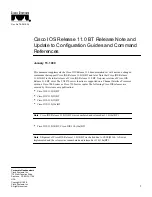
Flag
Parameter
Description
management GUI.
FSName
, the file-system name, can be 1 to 16
characters in length, and the name must be unique
among all file systems in the cluster.
-V
Displays command version information.
Table 4.1. Command Options:
gfs_mkfs
2. Mounting a File System
Before you can mount a GFS file system, the file system must exist (refer to
Section 1, “Making
a File System”
), the volume where the file system exists must be activated, and the supporting
clustering and locking systems must be started (refer to
Chapter 3, Getting Started
and
Configuring and Managing a Red Hat Cluster. After those requirements have been met, you can
mount the GFS file system as you would any Linux file system.
To manipulate file ACLs, you must mount the file system with the
-o acl
mount option. If a file
system is mounted without the
-o acl
mount option, users are allowed to view ACLs (with
getfacl
), but are not allowed to set them (with
setfacl
).
Usage
Mounting Without ACL Manipulation
mount -t gfs BlockDevice MountPoint
Mounting With ACL Manipulation
mount -t gfs -o acl BlockDevice MountPoint
-o acl
GFS-specific option to allow manipulating file ACLs.
BlockDevice
Specifies the block device where the GFS file system resides.
MountPoint
Specifies the directory where the GFS file system should be mounted.
Example
Chapter 4. Managing GFS
18
Summary of Contents for GLOBAL FILE SYSTEM 4.6
Page 1: ...Global File System 4 6 Red Hat Global File System ISBN N A Publication date...
Page 4: ...Global File System...
Page 12: ...xii...
Page 20: ...8...
Page 24: ...12...
Page 55: ...fileC Example 43...
Page 56: ...44...
Page 60: ...48...
















































